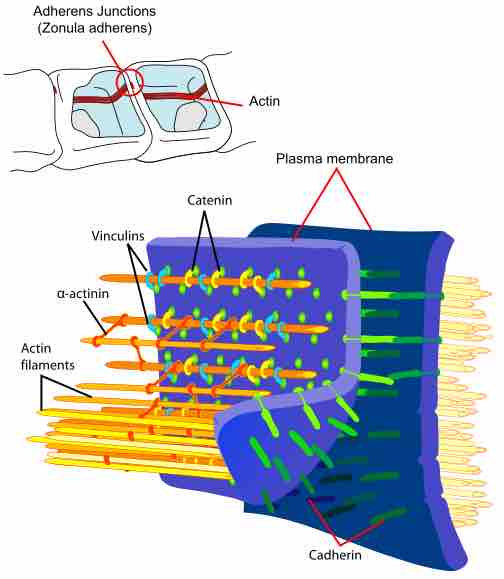Adherens Junctions
Adherens junctions are also referred to as zonula adherens, intermediate junction, or as belt desmosomes. Zonula means small zone or belt-like, and adherens refers to adhesion (sticking together). As a result, the zonula adherens often runs like a belt around the entire cell in a continuous fashion, and it acts as an adhesion belt.
Location and Function
This type of cell junction is located right below tight junctions and provides a strong bond between the sides of adjacent epithelial cell membranes. While other junctions, like tight junctions, provide some support for and fusion of adjacent cells, their resistance to mechanical stress is relatively small compared to the much stronger adherens junctions.
Structure and Composition
The zonula adherens is composed of several different proteins:
- The actin microfilaments of the cytoskeleton (the internal skeleton of the cell).
- Anchor proteins, found inside each cell. These are called alpha-catenin, beta-catenin, gamma-catenin (aka plakoglobin), vinculin, and alpha-actinin. They link the actin microfilaments to the cadherins.
- Cadherins, namely E-cadherin. These are transmembrane adhesion proteins, whose main portions are located in the extracellular space.
The extracellular part of one cell’s cadherin binds to the extracellular part of the adjacent cell’s cadherin in the space between the two cells. Each cell’s cadherin molecule also contains a tail that inserts itself inside its respective cell.
This intracellular (within the cell) tail then links up to catenin proteins to form the cadherin–catenin complex. This complex binds to vinculin and alpha-actinin; these two proteins are what link the cadherin–catenin complex to the cell’s internal skeletal framework (the actin microfilaments).
The extracellular portions of the cadherin molecules of adjacent cells are bonded together by calcium ions (or another protein in some cases). This means that the functional as well as morphological integrity of the adherens junctions are calcium dependent. If you were to remove calcium from the equation, this type of cell junction would disintegrate as a result.

The structural proteins in an adherens junction
These are the principal interactions of structural proteins at a cadherin-based plasma membrane adherens junction. Actin filaments are associated with adherens junctions in addition to several other actin-binding proteins.